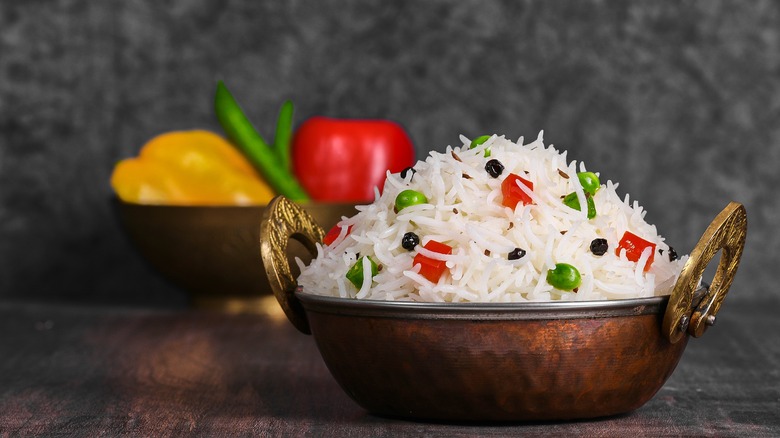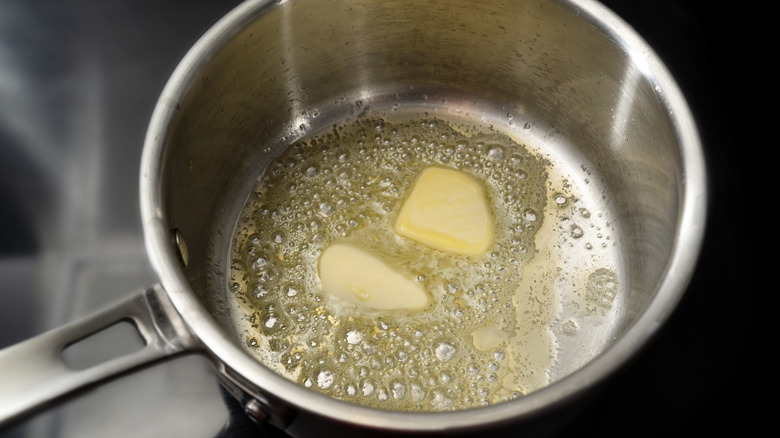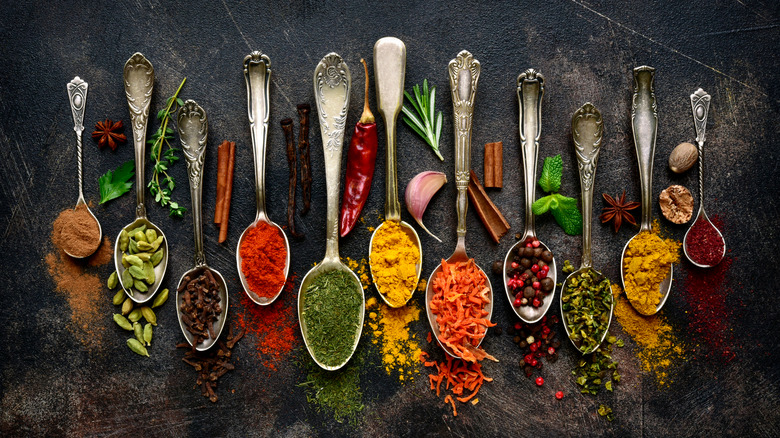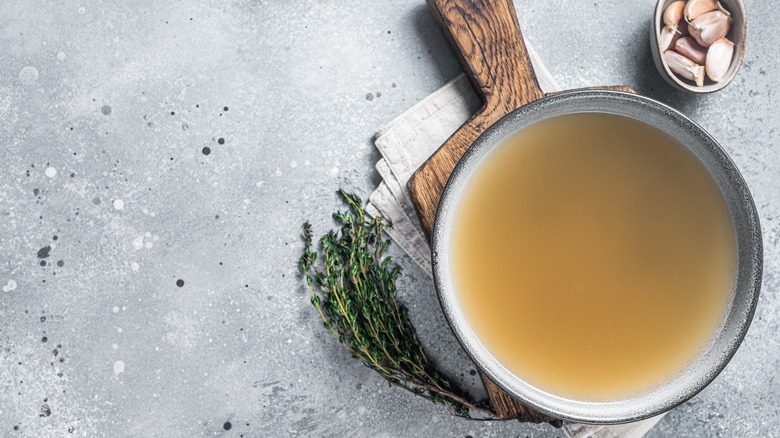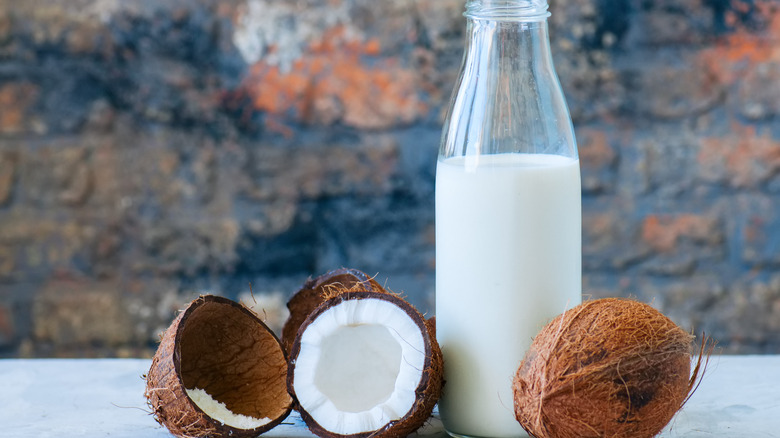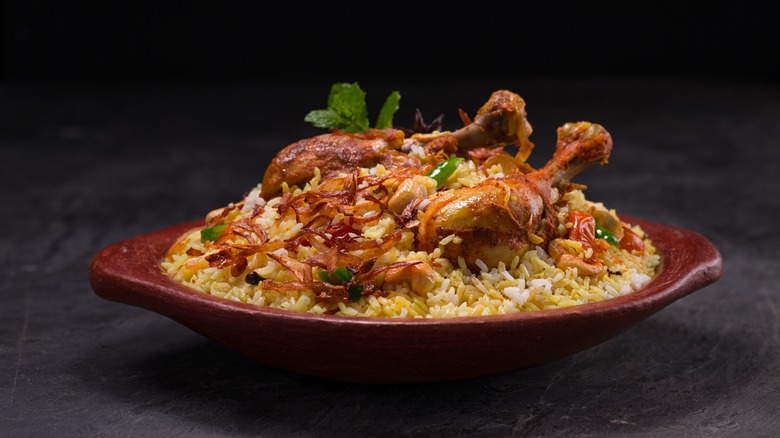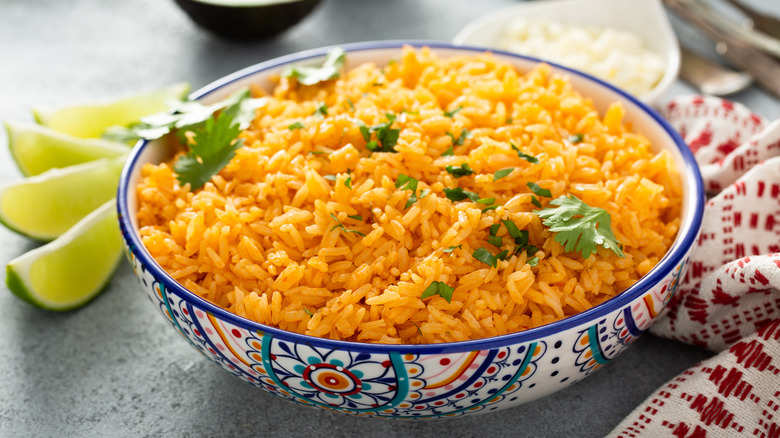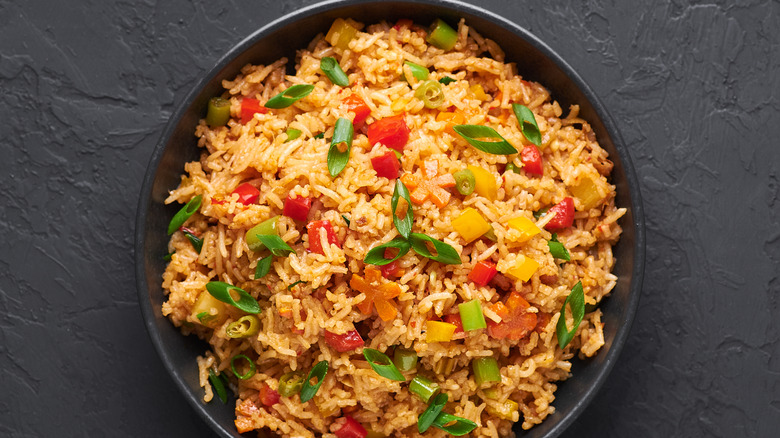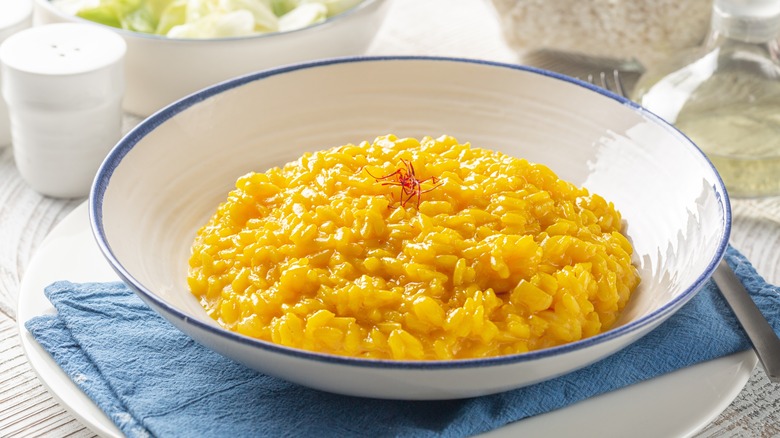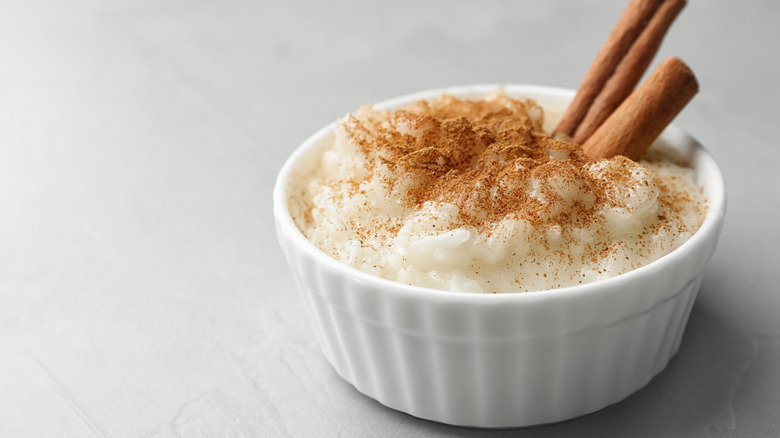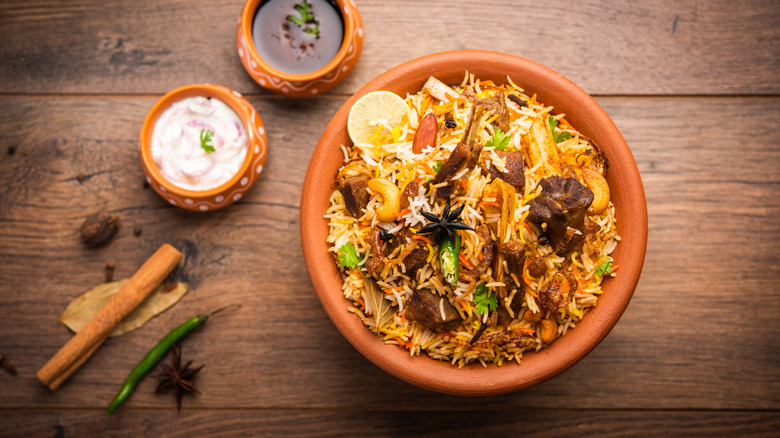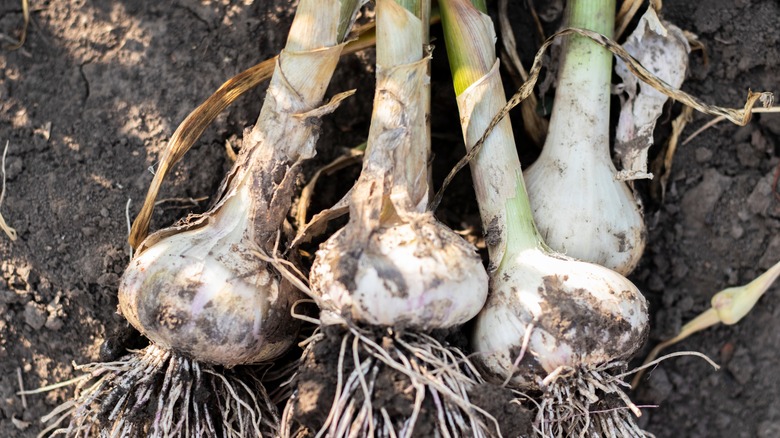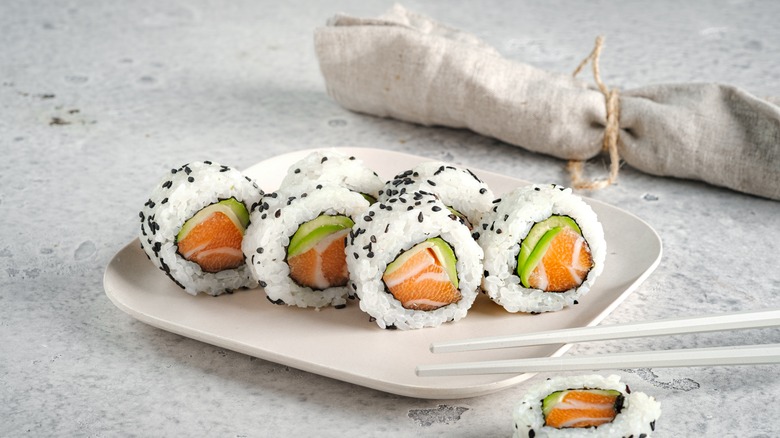14 Ways To Add More Flavor To White Rice
When it comes to grains, white rice may not seem like the most exotic option out there. But that doesn't have to be the case. White rice can quickly become a lot more exciting with only a little extra effort.
How so? For a lot of people, white rice basically means plain steamed white rice. But there is a lot more to the grain. In fact, adding various seasonings, experimenting with cooking liquids, and trying out other methods of flavoring will quickly spruce up white rice and make it a more complex and unique part of any meal.
Cooking rice using new methods has added benefits in addition to expanding your collection of ingredients. For one, rice really goes with just about everything, and you may find your way to new cuisines through experimentation. It also offers convenience: White rice is quite versatile. It's complete on its own, as a side dish, as the base of a main course, and even as a dessert.
So if your rice-cooking habits have become dull, and you're interested in changing things up, there are several different ways of adding vibrancy and flavor to white rice.
1. Use butter and salt
One of the most basic ways to add a little extra flavor to plain white rice is pretty simple and can often easily be done with ingredients you already have at home. All you need to do is add a little bit of butter and salt, which can help make the rice fluffier and richer.
There are a few ways to go about it. The first one is to melt a little butter (only a couple of tablespoons) in a pot, toast the rice for a couple of minutes, and then add water and cook the rice as you normally would.
This allows the rice to toast and will produce some undeniably fragrant smells in your kitchen. The second method is even simpler: Simply cook your rice in water as you would normally, but add those couple tablespoons of butter directly to the water. Once the rice boils, stir well to incorporate the butter, and then let it steam as it normally would.
If you use unsalted butter, you may want to add a little salt as well; if not, those couple of tablespoons of butter will add some substantial flavor on their own.
2. Incorporate bay leaves
Bay leaves are a somewhat strange spice. They are often invaluable in soups, curries, and countless other dishes as they certainly impart a distinct flavor. But they also aren't typically eaten: While they're not "inedible," bay leaves are often taken out of dishes prior to serving.
So what exactly are bay leaves? Bay leaves come from the bay laurel tree (per Auguste Escoffier School of Culinary Arts) and are commonly sold and used in dry form, as they can readily be stored this way. While "true" bay leaves are often known as Turkish bay leaves, there is a somewhat similar type of bay leaf that comes from California.
Bay leaves can add a depth of flavor to plenty of dishes, and that includes rice. Adding one or two dried bay leaves to the rice's cooking liquid can give it a little something extra and will make it much more fragrant.
Just be sure that the leaves are still fresh, which can simply be done by smelling them: Bay leaves tend to be the kind of spice people forget about, so make sure yours are still good before using them.
3. Spice up your rice
Bay leaves aren't the only way to add complexity and flavor to rice through spices. In fact, there are a limitless number of additions you can try, and that includes making your own blends and figuring out what best suits you and the meal that you're making.
But it helps to have somewhere to start out: Spices like cumin, saffron, five-spice powder, and many others can all be a way to try something new and exciting with white rice. These spices all have their particular strengths. Cumin (and similar spices like cardamom and cinnamon) can help lend an Indian-style flavor to rice, while five-spice-infused rice may go particularly well with a Chinese-style stir fry.
Best of all, adding spices is simple to do. You can add them straight into the cooking liquid (making sure to stir so they are fully mixed in). Alternatively, frying them a little in oil or butter at the outset can help make them especially fragrant.
4. Substitute water with chicken broth
Who says rice needs to be cooked in water? It turns out the cooking liquid you choose can have a dramatic effect on the rice's overall flavor, and chicken broth is one of the simplest substitutions you can make for the water in the rice-cooking process.
You can do this by substituting all the water in the recipe (or even just 50 percent) for broth. Chicken broth is usually chicken meat that is simmered with veggies, herbs, and maybe a few spices, and it's a hearty and nutritious way to add depth of flavor to plain rice quickly.
Chicken broth is pretty easy to make at home (see this chicken stock recipe, which is similar to "broth" but includes bones) but it can also be purchased at any grocery store.
If you are vegetarian, you can still apply the same principle by substituting vegetable broth for water (which can also be conveniently made at home). And if you want to get even more exotic, other types of broth, like beef broth, can add their own flavor profiles to white rice.
5. Use coconut milk
Chicken broth and other broths are not the only cooking liquid substitutions you can make for rice. Coconut milk is another fantastic and unique choice for rice. Coconut milk, which comes from mature coconut flesh that has been blended with water and strained, is a staple in a wide variety of ethnic cuisines, and it is used in everything from soups to desserts
It's usually not something you can make at home. But it's easy to find, and it can also be a wonderful addition to rice. The result is creamy, rich rice that pairs nicely with Indian and Thai dishes, among others.
True "coconut rice" is also extremely easy to make. The recipe calls for basmati rice, but short-grain white rice can also work well. The recipe suggests using a little sugar, which you can adjust based on how sweet you want to make it and the overall meal it is a part of. You'll be surprised how exotic and simple a dish it is and how much it opens up the possibilities of what you can do with white rice.
6. Add meat to rice
One reason rice can sometimes start to feel boring is that it's pretty basic on its own. But white rice does not have to be cooked solo. In fact, one of the most effective ways to jazz up rice is by cooking it with other ingredients, like meat and veggies.
Take this one-pot chicken and rice recipe. The recipe, which is literally just chicken, rice, and spices, calls simply for cooking well-seasoned chicken thighs in oil, removing them and adding rice and chicken broth (remember, that broth imparts its own flavor), and then re-adding the chicken and cooking everything together.
It's a complete meal that can be made in under an hour. And it also saves time and space: It requires using one pot and avoiding excess dishwashing while providing a full and hearty meal in the process.
Variations on this sort of recipe (using veggies, tofu, fish, and other ingredients) are easy to experiment with once you've got the basic procedure down.
7. Cook rice with orange juice
It might sound a little strange, but there is one other liquid that can add some pretty interesting and unexpected flavors to white rice: Orange juice. Admittedly, it is fair to say that orange juice-cooked rice may not work well for every dish.
Similar to lemon, using orange juice as a cooking liquid for savory recipes can add citrusy, sweet notes to steamed rice without overpowering the rice (or making it unpalatable). What's more, orange juice will impart a yellow-orange color to rice, potentially making it uniquely attractive for whatever meal you're making.
This type of rice may work particularly well with curries and similar dishes, where the slight sweetness of the rice pairs nicely with curried or spicy meats or vegetables. And if you're not so sure, try adding only a little orange juice on a small portion at first (along with water) to get a sense of the flavor and figure out if it's right for you.
8. Make Spanish rice
If you do not have the time to make a complex rice dish like paella, you can still do something very similar with basic white rice at home. The Shortcut Spanish Rice recipe packs a ton of flavor, but it can be made in half an hour, which is a fraction of the time of a more complicated dish
What's the trick? Toasting rice in melted butter has a nice effect, while adding cumin brings out recognizable flavors. But adding a salsa in which to cook the rice is especially key. You'll cook the rice in a 1:1 ratio with the addition of salsa and water, which infuses it with rich tomato flavors.
Your choice of salsa will also add to the rice's spiciness. Salsa, of course, can easily be purchased in the grocery store. But for the freshest version (and to most closely control the level of "heat" in the finished product), consider making your own salsa at home.
9. Make fried rice
Rice isn't necessarily done when it's "done." If you have cooked steamed rice or even day-old rice sitting in the fridge, frying it, either on its own or with vegetables, meat, or other items, can give it a flavorful second life.
Never made fried rice? It's not hard to do. It's best done with pre-cooked and chilled white rice, as freshly steamed white rice can be mushy and difficult to fry effectively. The fried rice recipe instructs you to start by cooking your fresh veggies in oil (here, onions, carrots, and broccoli, though you can feel free to experiment) and letting them soften before adding the rice.
At this stage, sesame oil is key to really adding deep flavor. As the rice cooks, you'll want to whisk an egg with some soy sauce (soy sauce is also key for the saltiness and umami flavors). Finally, reserve one side of your pan for the egg, add it, and let it cook. Then, add a little more soy sauce (and peas if using), and voila, you've made a fresh second meal out of leftovers!
10. Add in cheese
Risotto is a creamy Italian rice dish that calls for arborio rice, which is cooked slowly in stock to make the rice extremely rich. Whether you intend to make "true" risotto or not, you can add cheese to regular white rice to make it creamy and delicious, almost akin to a rice-based version of mac and cheese.
Adding cheese to rice is pretty simple, and you can experiment with different types of cheeses: Parmesan, pecorino romano, cheddar, or others, depending on the flavor you are after. Cheese can be effectively incorporated when the rice has stopped cooking but is still hot and on the stove; the heat in the rice should quickly melt any (grated or finely chopped) cheese, allowing you to mix it in easily.
The simple stove-top way described above is effective and pairs well with veggies cooked on the side. But for something even more complex, you can try cooking rice on its own and incorporating it into a cheesy rice casserole.
11. Try a sweet dish
Rice doesn't just have to be a savory part of dinner: It can also be the base of a delicious dessert, like rice pudding. Rice pudding is a staple dessert in many cultures, and it can be both cooked on the stovetop or baked in the oven (this tasty rice pudding recipe uses the latter method).
Rice pudding is also very simple to make, and it can be made by both experienced bakers and novices alike. To make, simply mix rice with milk (and evaporated milk) as well as sugar, vanilla, and salt, add it to a greased baking dish, sprinkle some cinnamon on top, and bake the mixture in the oven.
A tasty dessert (or breakfast, if that's what you prefer) will be ready quickly and can be easily livened up with additional spices (like nutmeg or ginger) or topped with fresh or dried fruit and even jam.
12. Make homemade rice pilaf
Fluffy rice pilaf is another easy way to add extra flavor and definition to your rice. Best of all, it can be done with only a few ingredients, and a boxed recipe really isn't necessary. But first, what exactly is pilaf?
Pilaf, like risotto, is essentially a culturally specific way of preparing rice, often with other foods mixed in. It traces its origins to the Middle East and Asia (rather than Italy). Pilaf uses much less liquid than risotto, and it does not have a "creamy" texture. Rather, it tends to be a fluffy rice dish. Pilaf also tends to be much faster to make than risotto.
For an easy homemade example, check out this lemon rice pilaf recipe. Like most rice pilaf dishes, it calls for cooking onion and garlic in oil at the outset, toasting the rice, and then adding broth and other spices like dill, parsley, and oregano as it cooks. But this one notably calls for both lemon juice and zest, which adds a tangy and citrusy flavor to the final dish.
13. Eat it with plenty of garlic
Garlic is one of the most ubiquitous ingredients in dishes of all types, and rice is no exception. According to the National Institute of Health, this edible bulb has a long history: It's used in ancient Egyptian, Greek, Roman, and Chinese cultures, among others) and has notable health benefits, particularly for cholesterol and blood pressure.
The health benefits are a great plus, but for many cooks, it is the singularly strong flavor and aroma of garlic that makes it so essential. Fortunately, there are innumerable rice dishes that make good use of this plant.
For instance, this simple but stellar rice pilaf dish calls for roasting garlic in the oven as you prepare pilaf and then mixing in the softened (and milder) garlic once it has finished baking. Garlic also plays a starring role in this Brazilian rice recipe, which can be a fantastic side dish for any number of meals.
14. Use vinegar
Vinegar may not be the first ingredient that comes to mind when you think of cooking rice: That is, unless you're a sushi fiend, in which case, it might be. If you like to eat sushi but have not tried making sushi rice at home, it's actually easier than you might think. A basic sushi rice recipe only calls for sugar, salt, rice vinegar, and kombu.
Kombu is a type of sea vegetable that may help digestion and imparts flavor and nutrients as it cooks. The vinegar is heated with sugar and salt and then cooled in a separate dish. Once the rice is done, the vinegar mixture is poured over the rice and mixed in.
This type of rice is delicious on its own, and it makes a great side dish for Japanese and similar dishes. But if you want to keep going and try rolling your own sushi with your prepared rice, this recipe can help you get started.
